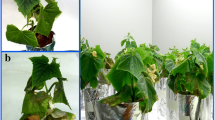Abstract
A greenhouse experiment, with Okra (Abelmoschus esculentus L.) as the test crop, was conducted on twenty-one soils ranging in Olsen's extractable phosphorus from 1.8 to 15.5µg Pg−1 soil. The experiment was conducted at Punjab Agricultural University, Ludhiana, India. The soils were nonsaline with pH ranging from 7.7 to 8.6. A critical level of 2.55µg Pg−1 soil was predicted by Cate and Nelson's (1971) statistical procedure. Because of a wide range in relative yields, this value did not accurately predict response to applied P. An approach to compute minimum response to applied fertilizer, which is likely to be obtained at a particular Olsen P level, has been presented. It involves calculation of lower 60 percent confidence limits for relative yield and fitting loge-linear regression to the transformed data. The regression was tested on a published data set and was found to hold well.
Similar content being viewed by others
References
Bates TE (1989) Prediction of phosphorus uptake from 89 Ontario soils using soil tests. Proc. Int. Symp. Soil Testing and Plant Analysis, Fresno, California, Aug. 14–19, 1989
Bishnoi SR, Brar SPS and Singh B (1987) Nitrogen and phosphorus nutrition of Okra (Abelmoschus esculentus L.) for seed production. Proc. National Symp. Macronutrients, PAU, Ludhiana, India, Dec. 21–23, 1987
Brar SPS, Bishnoi SR and Singh B (1987) Effect of soil characteristics on the phosphorus supplying capacity of soils. Proc. National Symp. Macronutrients, PAU, Ludhiana, India, Dec. 21–23, 1987
Cate RB and Nelson LA (1971) A simple statistical procedure for partitioning soil test correlation data into two classes. Soil Sci Soc Amer Proc 35: 658–659
Dhillon NS, Vig AC, Chand M, Singh B and Dev G (1987) Critical level of phosphorus in soils of Punjab and response of pearl millet to applied phosphate. J Indian Soc Soil Sci 35: 38–43
Enwezor WO (1977) Soil testing for phosphorus in some Nigerian soils: I. Comparison of methods of determining available phosphorus in soils of southeastern Nigeria. Soil Sci 123: 48–53
Johnston AE, Lane PW, Mattingly GEG, Poulton PR, Hewitt MV (1986) Effects of soil and fertilizer P on yields of potatoes, sugarbeet, barley and winter wheat on a sandy clay loam soil at Saxmundham, Suffolk. J Agric Sci (Camb) 106: 155–167
Olsen SR, Cole CV, Watanabe F and Dean LA (1954) Estimation of available phosphorus in soils by extraction with sodium bicarbonate. US Dept Agric Circ, 939
Author information
Authors and Affiliations
Rights and permissions
About this article
Cite this article
Benbi, D.K., Brar, S.P.S. The interpretation of Olsen extractable P values in relation to recommendations for the fertilizer requirements of crops. Fertilizer Research 32, 223–227 (1992). https://doi.org/10.1007/BF01048784
Received:
Accepted:
Issue Date:
DOI: https://doi.org/10.1007/BF01048784




